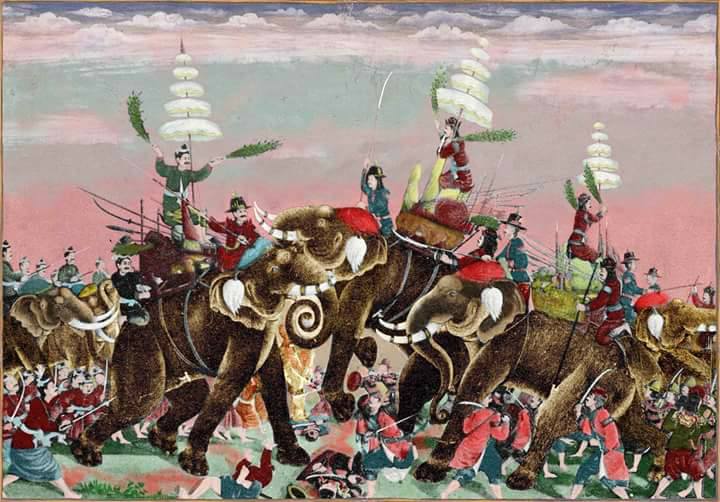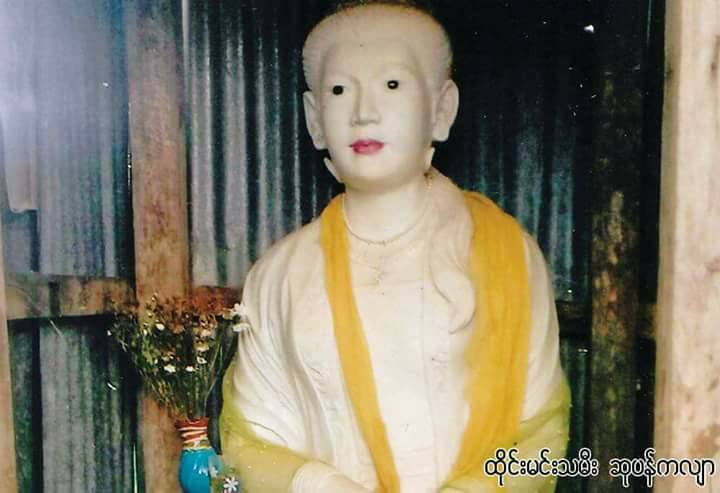The people who run the Kanbawza Thardi Palace in Bago – a replica of the King Bayinnaung’s 16th century palace – have devised a clever way to entice Thai tourists to visit the big, golden building: place a statue of an ancient Thai princess in the yard.
This might not sound super clever, but it gets more interesting when you learn what ideas that princess represents, respectively, in Thai and Burmese cultures.
The statue that was placed in the palace courtyard on Dec. 11 depicts a sitting Princess Suphankanlaya, who is mentioned in Burmese records only in passing as Bya Eindra Dewi, a secondary wife of the legendary King Bayinnaung, who expanded the Burmese empire to its greatest extent in history.
From a Burmese perspective, there is nothing particularly interesting about this lady.
The common narrative about Suphankanlaya in Thailand, however, is far more colorful (though not fully verifiable). According to legend, Suphankanlaya was sent by her father, King Sanpet I of Ayutthaya, in 1571 to marry Bayinnaung in exchange for the return of her brothers from captivity in Bago. Her presence at the Burmese court was meant to consolidate Bago’s dominion over Ayutthaya.
The legend continues that when Bayinnaung died in 1581, Suphankanlaya was married to his son and successor, Nanda. In 1584, her father revolted against Nanda and sparked a war that would last several years. In 1590, the Thai king died, and his son Naresuan succeeded him and continued fighting for independence from the Burmese. In 1593, Naresuan defeated Nanda’s son, Crown Prince Mingyi Swa, in a legendary duel on elephant back.

(Burmese records say Mingyi Swa was killed by a gunshot and don’t mention an elephant duel.)
When Nanda heard about his son’s death, the Thai legend says he struck Suphankanlaya, killing her and the 8-month-old fetus she was carrying. In the centuries since, Suphankanlaya has come to symbolize self-sacrifice and the bittersweet fruits of Thai national assertiveness.
Following the 1997 Asian financial crisis, Suphankanlaya’s popularity in Thailand grew to the point that she considered is considered a national deity. Around that time, a businesswoman claimed the princess had saved her from bankruptcy and commissioned historical research and a romantic novelization about Suphankanlaya’s life. The historian reportedly warned that not much about the princess’s life is historically traceable, but a cult around her personality formed nonetheless with the help of the novel and subsequent films about her life.
No historically accurate image of Suphankanlaya exists, so pictures and sculptures of her have been modelled after Thai beauty queens.
The irony of Suphankanlaya’s likeness being placed in the replica of Bayinnaung’s palace (it was built in the 1990s after the original was destroyed in the 1590s) is that to many Thais, she represents a particularly anti-Burmese strain of Thai nationalism. The Thai army, which embraces her cult and has erected a monument to her, also commissioned a biography of Suphankanlaya in 1998 that highlights the alleged cruelty of her Burmese husbands.
From the Thai perspective, it would make sense to want to visit a shrine that commemorates the country’s independence. However, Myanmar officials have decided to look at it differently.
Nyo Myint Tun, director of the Department of the National Museum, which oversees the palace’s operations, told Eleven: “The history was that the Thai king sent his daughter as a gift to King Bayinnaung, who built the second Myanmar Empire, to promote bilateral relations. She died in Myanmar. Visitors from Thailand mostly come here to see her.”



